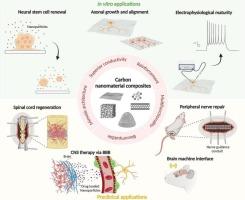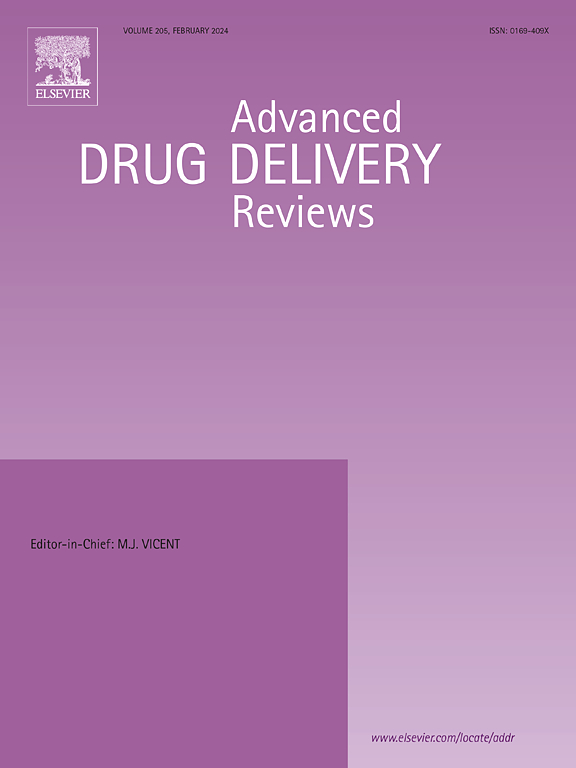Advances in carbon nanomaterials and their polymeric composites in neural tissue engineering
IF 17.6
1区 医学
Q1 PHARMACOLOGY & PHARMACY
引用次数: 0
Abstract
Carbon‐based nanomaterials (CBMs) and their polymeric composites have garnered widespread interest in treating neurotrauma and neurodegenerative diseases, where restoring damaged central and peripheral nervous systems remains a persistent clinical challenge. These materials provide exceptional electrical conductivity, mechanical robustness, and tunable nanoscale architectures conducive to guiding neuronal growth, synaptic connectivity, and targeted biomolecule delivery. In this review, we explore the rationale, recent advances, and translational potential of CBM scaffolds in promoting neuronal survival, neurite outgrowth, and functional maturity across various experimental models. We detail key fabrication strategies, including electrospinning, phase inversion, 3D bioprinting, and pyrolysis that enable precise control over scaffolds’ structural and mechanical properties while facilitating the incorporation of neurotrophic factors, genes, and therapeutic drugs. Emerging in vivo findings suggest that CBM nanocomposites promote regenerative outcomes in peripheral nerve injuries at levels comparable to, or exceeding conventional autografts, underscoring their promise as off‐the‐shelf solutions. Nonetheless, concerns persist regarding large-scale manufacturing, cytotoxicity, and meeting regulatory standards for clinical use. By highlighting cutting-edge innovations and remaining bottlenecks, this review aims to guide future research endeavors in harnessing CBM scaffolds for safe and effective neural tissue repair.


碳纳米材料及其聚合物复合材料在神经组织工程中的研究进展
碳基纳米材料(CBMs)及其聚合物复合材料在治疗神经创伤和神经退行性疾病方面引起了广泛的兴趣,其中修复受损的中枢和周围神经系统仍然是一个持续的临床挑战。这些材料具有优异的导电性、机械稳健性和可调的纳米结构,有助于指导神经元生长、突触连接和靶向生物分子传递。在这篇综述中,我们探讨了CBM支架在各种实验模型中促进神经元存活、神经突生长和功能成熟的基本原理、最新进展和转化潜力。我们详细介绍了关键的制造策略,包括静电纺丝、相转化、3D生物打印和热解,这些策略可以精确控制支架的结构和机械性能,同时促进神经营养因子、基因和治疗药物的结合。新出现的体内研究结果表明,CBM纳米复合材料促进周围神经损伤的再生结果的水平与传统的自体移植物相当,甚至超过传统的自体移植物,强调了它们作为现成解决方案的前景。尽管如此,对大规模生产、细胞毒性和临床使用是否符合监管标准的担忧仍然存在。本文通过对目前研究的前沿创新和存在的瓶颈进行综述,旨在指导未来利用CBM支架进行安全有效的神经组织修复的研究
本文章由计算机程序翻译,如有差异,请以英文原文为准。
求助全文
约1分钟内获得全文
求助全文
来源期刊
CiteScore
28.10
自引率
5.00%
发文量
294
审稿时长
15.1 weeks
期刊介绍:
The aim of the Journal is to provide a forum for the critical analysis of advanced drug and gene delivery systems and their applications in human and veterinary medicine. The Journal has a broad scope, covering the key issues for effective drug and gene delivery, from administration to site-specific delivery.
In general, the Journal publishes review articles in a Theme Issue format. Each Theme Issue provides a comprehensive and critical examination of current and emerging research on the design and development of advanced drug and gene delivery systems and their application to experimental and clinical therapeutics. The goal is to illustrate the pivotal role of a multidisciplinary approach to modern drug delivery, encompassing the application of sound biological and physicochemical principles to the engineering of drug delivery systems to meet the therapeutic need at hand. Importantly the Editorial Team of ADDR asks that the authors effectively window the extensive volume of literature, pick the important contributions and explain their importance, produce a forward looking identification of the challenges facing the field and produce a Conclusions section with expert recommendations to address the issues.

 求助内容:
求助内容: 应助结果提醒方式:
应助结果提醒方式:


